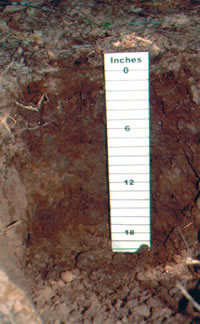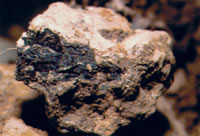

Soil: Fine, smectic, thermic. Ustic Eqiaquert.
Soil Description. The Ustibuck soil series is the principal hydric soil series that forms this wetland type. Ustibuck soils formed in clay sediments deposited on depressional areas of flood plains where fine silts and clay sediments have had time to filter out. The depositional materials that form this soil are red sediments from sandstones and shales of Permian geologic age. These soils have developed under a steady influx of sediments and are recent in age. They typically have dark, reddish brown clay surface layers and reddish brown subsoils. The presence of redox features depends on the age of the soils and the duration of saturation.
Soil Profile
A1: 0 to 8 inches, dark reddish brown (5YR3/3) clay; strong fine granular structure; hard, firm; many fine and medium roots.
B: 8 to 20 inches, reddish brown (5YR 4/4) clay; moderate medium and fine blocky structure; extremely hard, very firm; many (30%) yellowish red (5YR 5/6) redox concentrations and many (35%) reddish gray redox depletions; common medium and coarse roots.
Landuse. This wetland type is often converted to livestock production. Areas are sometimes drained by channelization and diking, and pasture grasses are established. Some areas are sufficiently drained so that limited crop production can occur. When cleared or diked areas are abandoned, green ash, cottonwood, black willow, curly dock, smartweed and annual grasses predominate. Areas adjacent to these wetlands are commonly used for cropland, rangeland or improved pasture.